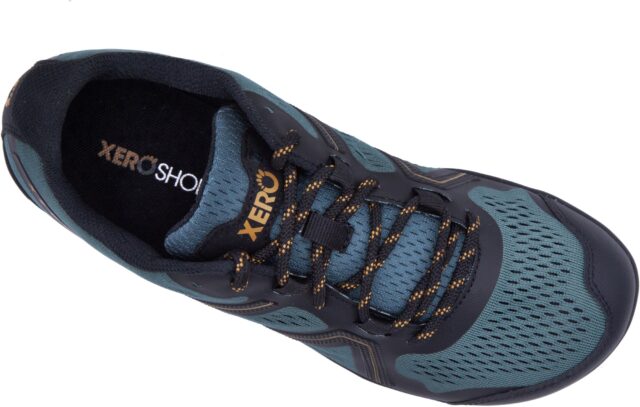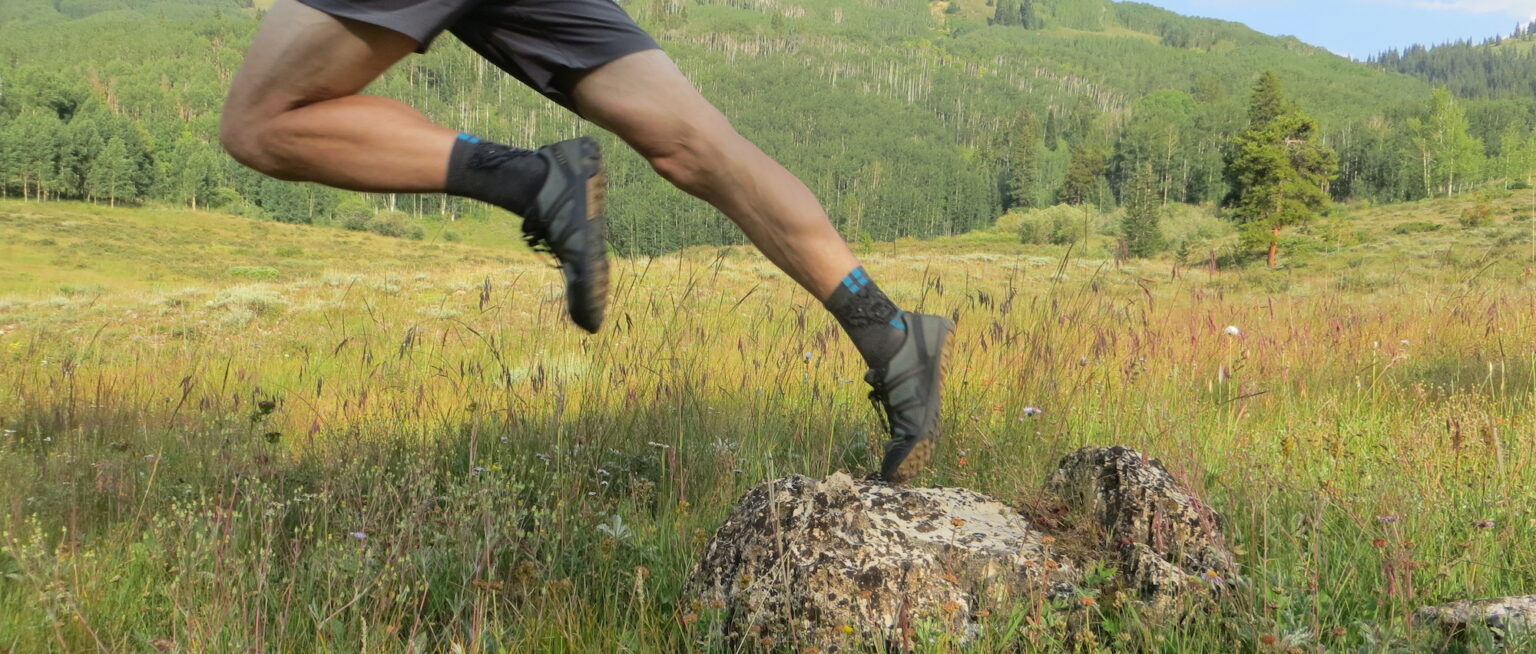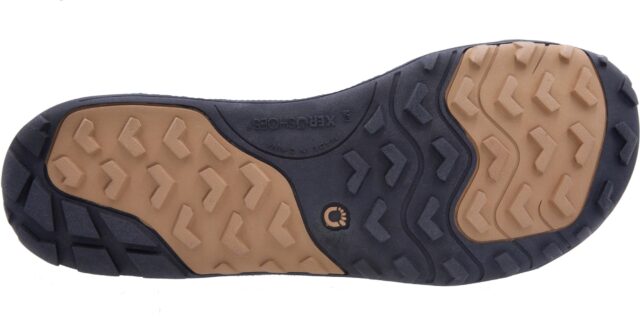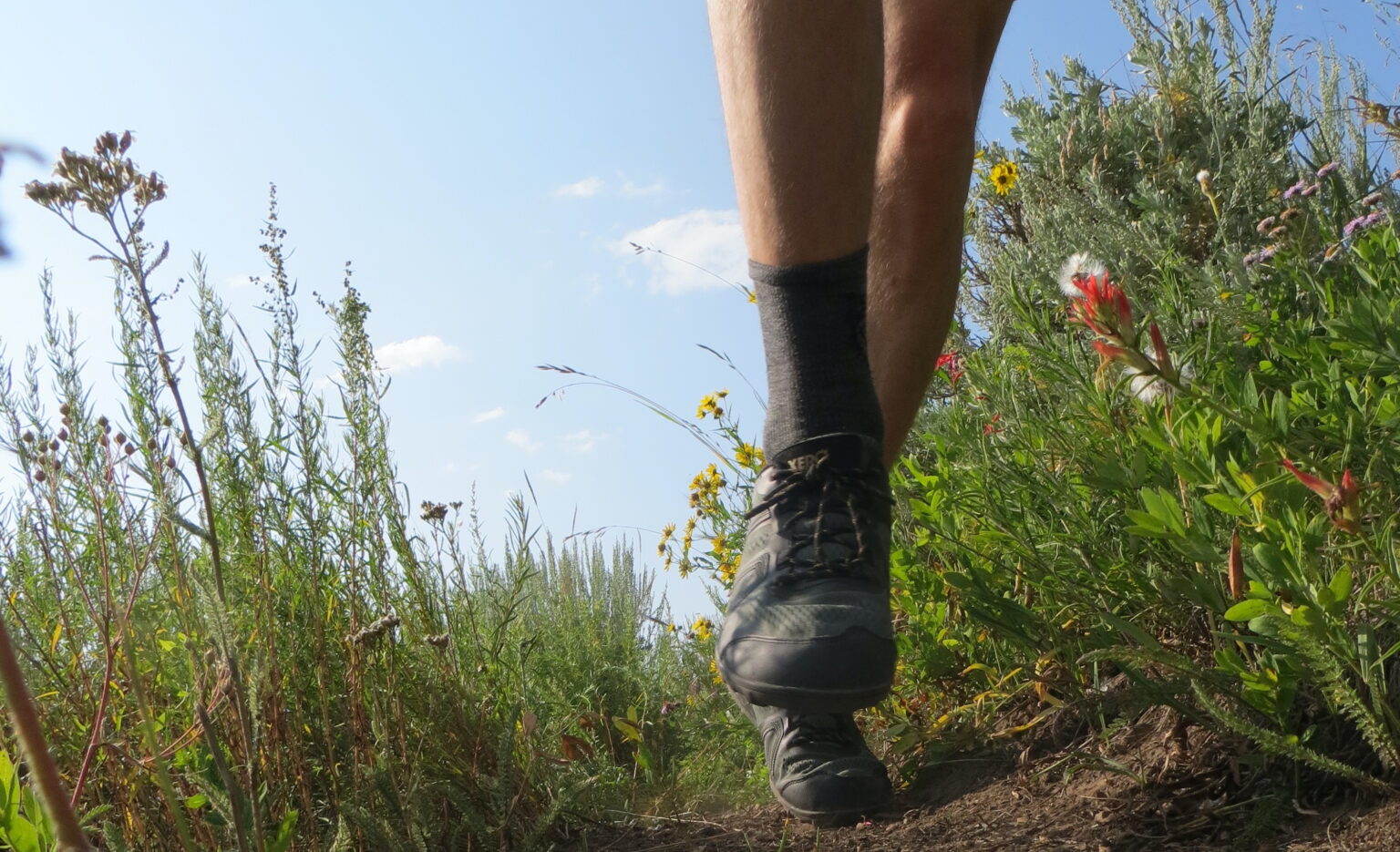Xero Mesa Trail
Test Locations: Gunnison — Crested Butte, Colorado
Test Duration: 55 miles
Stated Stack Height: 8 mm (5 mm outsole + 3 mm foam midsole)
Stated Heel-to-Toe Drop: 8 mm
Stated Features:
- Quick-drying, breathable mesh uppers with moisture-wicking linings
- FeelTrue® soles with 3.5 mm lugs
- TrailFoam® embedded in the soles adds protection and force absorption
- Shoes are covered by a 24-month manufacturer’s warranty and FeelTrue rubber outsoles are covered by the Xero 5,000 Mile Sole warranty program
- Natural feel, fit, and motion with wide toe box and zero heel-to-toe drop, huarache inspired design
- Vegan-friendly materials
Reviewer: 6’2″,160 lbs / 188 cm, 70 kg
Size Tested: US Men’s 10.5
Stated Weight per shoe (US Men’s Size 9): 215 g / 7.6 oz
Blister’s Measured Weight (US Men’s 10.5):
- Shoes + Laces: 224 g (left), 229 g (right)
- Insoles: 17 g (left), 17 g (right)
- Total: 241 g (left), 246 g (right)
MSRP: $119.99

Intro
The Xero Mesa Trail is a true minimalist running shoe designed to perform well with what Xero calls a “natural,” barefoot-inspired running style. The barefoot running trend has been around for quite some time now, and there are a whole slew of barefoot and barefoot-inspired running shoes on the market. My question was: how would the Mesa Trail function as a daily runner on the rocky trails and ridges of the mountains in the Colorado high country?
I tend to enjoy moderately minimalist running shoes with zero heel-to-toe drop and a wider toe box — so while the Mesa Trail is the most minimalist shoe I have run in, its feature set definitely looked appealing on paper. After testing the Mesa out on a variety of terrain, I have some thoughts both on how it handles in general, and where the specific style of running that Xero shoes encourage might fit into a running routine.
Fit
While the only way to know how a shoe will fit your particular foot shape is to go try it on, I’ll provide some general context on my experience with the Mesa Trail’s fit. For reference, my foot is not particularly wide or narrow, the height of my arches is fairly average (neither high nor low), and I tend to enjoy shoes with a wider toe box.
For a while, the Mesa Trail (and I believe Xero shoes in general) ran about a half size small. However, according to Xero’s website, they’ve changed their sizing and their shoes supposedly now run true to size. That being said, if you are unable to try on these shoes before purchasing, it would be worth doing some research in this department. I tested a Men’s size 10.5, which fit the length of my normally-size-10 foot nicely.

The Mesa Trail is a wider toe box shoe, so it definitely provides some extra room in the forefoot for your toes to splay out — much like shoes like the Altra Timp 3 or La Sportiva Jackal GTX. The Mesa Trail’s toe box feels pretty similar to the Timp 3 and Jackal GTX width-wise, but the Mesa Trail’s flexible mesh upper gives my feet a bit more volume above the toes — which I think gives the Mesa Trail a slightly roomier feel than the Jackal or Timp. From the arch back, the Mesa Trail hugs my foot a bit tighter, though perhaps not quite as securely as the Altra Superior 4. The Mesa’s midfoot / heel definitely felt a little sloppy to me at certain points, especially on off-camber and technical terrain, as well as the uneven ground of off-trail runs (more on that later). Still, I never had issues with my heel getting blisters or hot spots.
Weight
With a US Men’s size 9 coming in at a stated weight of 215 g / 7.6 oz per shoe, the Mesa Trail is planted firmly in the lightweight / minimalist / barefoot / barefoot-inspired category. Below is a list of comparisons to see how it stacks up to other, similar shoes on the market. All stated weights are for a US Men’s size 9:
164 g / 5.8 oz — Xero Speed Force
182 g / 6.4 oz — Vibram V-Trail 2.0
198 g / 7 oz — Merrell Trail Glove 6
210 g / 7.5 oz — Inov-8 Bare-XF v2
215 g / 7.6 oz — Xero Prio
215 g / 7.6 oz — Xero Mesa Trail
238 g / 8.4 oz — Altra Solstice XT
251 g / 8.8 oz — Altra Superior 5
272 g / 9.5 oz — Xero Terraflex
As you would expect at its weight, the Mesa Trail feels very light on the feet while running — even more so than the La Sportiva VK BOA (180 g / 6.3 oz – stated weight). A comparison I keep coming back to is that it feels like I am wearing slippers. Part of this is due to the thinness of the midsole (5 mm), which I’ll get into more below, but the Mesa’s light weight definitely adds to the slipper-like feel as well.
Upper
The Mesa Trail’s upper consists of a highly breathable mesh fabric lined with a moisture-wicking lining. This is reinforced with welded overlays (a sort of rubbery compound) around the middle of the foot that provide a bit of extra durability and support. Around the toe is a slightly stiffer band of rubber and foam to add a little protection if you are prone to stubbing your feet on rocks, roots, etc. However, like everything else on the Mesa Trail, these reinforcements are fairly minimal and don’t provide quite as much protection as the toe caps on La Sportiva’s Jackal GTX or the Altra Timp 3.

Midsole
With a stated stack height of 8 mm (5 mm outsole, 3 mm foam cushion, plus an optional 2 mm insole), the Mesa Trail is ideal for anyone looking for maximum trail feel — and definitely not ideal for those who prefer a shoe that absorbs impacts and mutes out the ground beneath them.

I find that you really do feel everything you put your feet on when running in the Mesa Trail, much more so than the Altra Superior, which is one of Altra’s most minimalist zero-drop shoes. That said, it is worth noting that the 5 mm outsole and 3 mm midsole combine to give the Mesa Trail a little more protection when compared to some of the most minimalist barefoot shoes on the market. That little bit of cushion does provide a small amount of protection from sharp objects, but I find that I really have to be light on my feet and intentional with my gait and foot placement, especially on rocky and technical trails. As such, I never opted to remove the 2 mm insole and the bit of extra padding it provides. While I can adjust my running style to accommodate the minimalist, Huarache-inspired design of the Mesa Trail, it is still not my first choice for longer runs, especially on rough trails. There is a fair bit of personal preference involved in shoe choices for long-distance runs, but after longer runs (over 10 miles) in the Mesa Trail, the softer parts of the soles of my feet get sore.
Outsole
The outsole of the Mesa Trail consists of a 5mm-thick flexible rubber compound that is studded with 3.5 mm lugs. The wider toe box, zero drop platform, thin midsole, and flexible outsole all add up to a shoe that requires a forefoot-striking gait with my ankles and knees absorbing the force of impact. The rubber compound of the sole is grippy enough for most situations, though I do slip a little on steeper rocks, and it is not nearly as tacky as the rubber compound on the outsole of the La Sportiva VK BOA.

On Trail
The best way to describe my opinion of the Mesa Trail is that I like it for what it is: a minimalist, barefoot-inspired running shoe that handles well on less technical singletrack. The Mesa is designed for a specific style of running (“natural,” forefoot striking, light on the feet) that incorporates a high level of trail feel. I live in an area where a lot of the trails are motorized (open to dirt bikes) and are consequently often filled with various sizes of cobbles / loose rocks. On those kinds of trails, I found the Mesa Trail’s cushioning / protection to be pretty lacking. However, on the smoother silt and clay soils that make up most of the running and mountain biking trails outside of Gunnison, the Mesa Trail really shines. For this reason, as well as its high level of breathability, I think it would make a great shoe for desert trails with more sand and slickrock, and fewer sharp, loose rocks.
In terms of dexterity, so long as I am intentional with my running gait and where and how I am placing my feet as I run, the Mesa Trail can handle most terrain well (with the caveat that you will feel most protrusions coming up from the trail). Where I found them to be lacking was in rock scrambling environments. The rubber on the outsole was less grippy than I would have liked in these scenarios, and even fully cinched down on my foot, I just didn’t feel stable on prolonged rock scrambles. I also think that it was these types of scrambling adventures that contributed to the accelerated wearing of the lugs on the outsole (see durability, below). Along with that, on off-trail runs, I found that small rocks and other objects found their way inside of the shoe much more than other shoes I have run in, such as Altra’s Timp 3 and La Sportiva’s VK BOA.
All in all, if you’re looking for a very minimalist, zero-drop shoe for smoother trails, the Mesa Trail performs admirably. For those who spend a lot of time on rocky, technical terrain, or who just know they prefer a more traditional shoe in terms of cushioning, there are definitely many better options.
Durability
While the Mesa Trail is more durable than I would expect from such a minimalist running shoe, there are a couple of areas where the construction is a little more fragile than I would like. After about 55 miles so far, the foam and rubber that wraps around the toe have held up very well. The same can be said for the seam where the uppers meet the outsole. However, the mesh fabric can be prone to tearing if you run off-trail or in brushy environments. I tore a small strip on the inside of the foot on a stick that ran through the outer mesh, but not the moisture-wicking lining.

In terms of the outsole, the bulk of the rubber is holding up, except for the lugs around the perimeter and on the tip of the toe. These show quite a bit of wear and a couple of the lugs on the toe have worn nearly completely off after a relatively low amount of mileage. It is worth noting that the majority of the trails where I live are very rocky and I also do a fair amount of off-trail running. If you run mostly on smooth, less technical, or not-so-rocky trails (where I think this shoe excels anyway), I think the outsole and mesh uppers would be likely to hold up for quite a bit longer.
It’s also worth mentioning Xero’s “5,000 mile sole warranty.” They say that if you wear the sole of their shoes down to 1 mm at the ball or heel of the shoe, they’ll let you replace the shoe at 60% off the MSRP.
Who’s It For?
To start, the Mesa Trail is going to make the most sense for runners who like a barefoot or barefoot-inspired running shoe and are open to or have already adjusted their running style to accommodate the minimalist nature of this sort of shoe. With that caveat in mind, this shoe handles most relatively smooth surfaces quite well. If you’re looking for a very light running shoe, it could also be a good option, though while the feather-light weight of the shoe is a benefit for keeping a quick cadence, its thin midsole can be a challenge if you are not used to the specific, natural running style more or less required by the design of the Mesa Trail.
As I said above, I would choose this shoe for running in the desert, which, for me, is often a springtime activity. And in my mind, the natural running style that requires a reactive running gait contributes to increased strength in the feet and ankles (so long as you don’t overdo it and get injured). For that reason, I might use the Mesa Trail to build strength early in the season. But once the high country opens up, I might go for something with (much) more cushion, such as the Altra Timp 3. In the barefoot-inpsired category in general, I’d say the Mesa Trail will appeal most to those who will be using it on smoother trails and who prioritize low weight and excellent breathability.
And in case it’s not clear, you should look elsewhere if you know you prefer a shoe with a substantial, more traditional midsole that absorbs impacts and makes the trail feel smoother than it is.
Bottom Line
If you like this sort of minimally cushioned, barefoot-inspired shoe and you are used to everything that comes with that, the Mesa Trail is definitely worth checking out — particularly for terrain that’s fairly smooth and / or if you want a really breathable, lightweight shoe. Its wider toe box allows toes to spread out and accommodates a more “natural,” forefoot-striking running gait. Personally, I would not choose this shoe as my daily runner due to the minimal cushioning and the loose, techy terrain around the Gunnison–Crested Butte Valley, but for the right person, it could be an excellent option for runs of just about any length on relatively consistent trail surfaces, and it definitely has its place in my lineup and training regimen.




Nice review as always. Any suggestions for a similar barefoot style shoe with a sole that is more durable with more grip? With maybe a little more cushioning/padding? I’ve gone through a few pairs of Merrel TrailGloves (v1 & 3, I think) but the latest versions have moved away from their barefoot inspired origins. I have numerous pairs of VivoBarefoot shoes & Luna Sandals so I’m quite at home on thin, flexible shoes but need something that’s really grippy and has some small/pointy stone protection.
Cheers.
Great review and echos my experience and complaints with the mesa. A little heavier runner here, and find myself leaning on my x talon for many of the rugged trails in Morrison, but on longer runs i got a shoe with more cushion (lone peak 5 rn). Loved your review on the king mt2 which look like a good option next for the 6-15 mile runs i like to do most
Very good and helpful review, thanks!
On sizing: You mean your foot is about 10 inches long (measured from heel to tip of the big toe??), and a Mesa Trail US 10.5 fits you well?
Thanks, Gernot